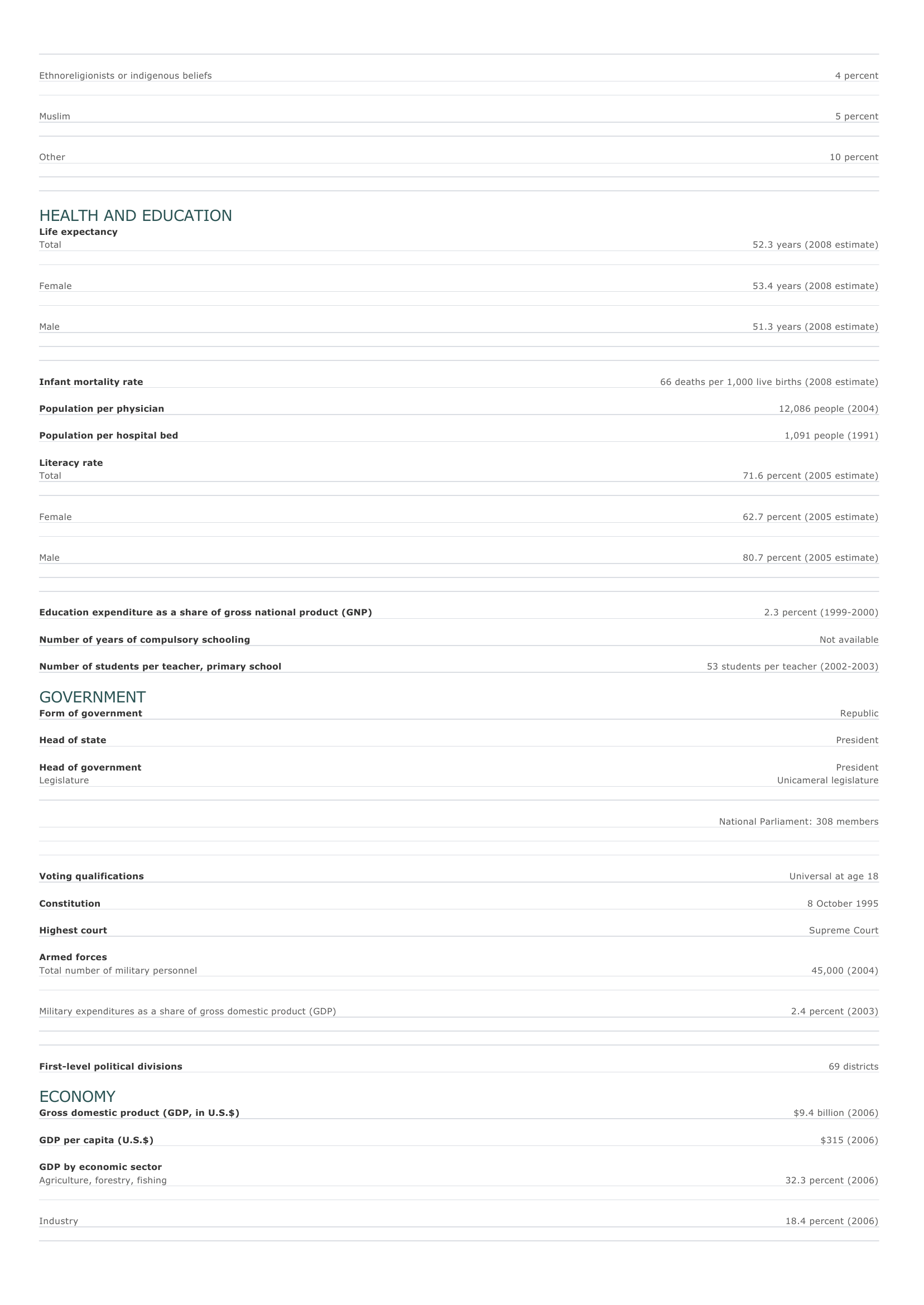Uganda Facts and Figures. BASIC FACTS Official name Capital Area Republic of Uganda Kampala 241,038 sq km 93,065 sq mi PEOPLE Population 31,367,972 (2008 estimate) Population growth Population growth rate 3.60 percent (2008 estimate) Projected population in 2025 56,744,814 (2025 estimate) Projected population in 2050 128,007,514 (2050 estimate) Population density 157 persons per sq km (2008 estimate) 407 persons per sq mi (2008 estimate) Urban/rural distribution Share urban 12 percent (2005 estimate) Share rural 88 percent (2005 estimate) Largest cities, with population Kampala 1,246,000 (2003 estimate) Jinja 86,520 (2002) Mbale 70,437 (2002) E ntebbe 57,518 (2002) Ethnic groups Ganda 18 percent Nyankole 10 percent Kiga 8 percent Soga 8 percent Iteso 6 percent Langi 6 percent Acholi 4 percent O ther 40 percent Languages English (official), Luganda, Swahili, other Bantu and Nilo-Saharan languages Religious affiliations Roman Catholic 41 percent Anglican 40 percent Ethnoreligionists or indigenous beliefs 4 percent Muslim 5 percent O ther 10 percent HEALTH AND EDUCATION Life expectancy Total 52.3 years (2008 estimate) Female 53.4 years (2008 estimate) Male 51.3 years (2008 estimate) Infant mortality rate Population per physician Population per hospital bed 66 deaths per 1,000 live births (2008 estimate) 12,086 people (2004) 1,091 people (1991) Literacy rate Total 71.6 percent (2005 estimate) Female 62.7 percent (2005 estimate) Male 80.7 percent (2005 estimate) Education expenditure as a share of gross national product (GNP) Number of years of compulsory schooling Number of students per teacher, primary school 2.3 percent (1999-2000) Not available 53 students per teacher (2002-2003) GOVERNMENT Form of government Head of state Head of government Legislature Republic President President Unicameral legislature National Parliament: 308 members Voting qualifications Universal at age 18 Constitution 8 October 1995 Highest court Supreme Court Armed forces Total number of military personnel 45,000 (2004) Military expenditures as a share of gross domestic product (GDP) First-level political divisions 2.4 percent (2003) 69 districts ECONOMY Gross domestic product (GDP, in U.S.$) GDP per capita (U.S.$) $9.4 billion (2006) $315 (2006) GDP by economic sector Agriculture, forestry, fishing 32.3 percent (2006) I ndustry 18.4 percent (2006) Services Employment Number of workers Workforce share of economic sector Agriculture, forestry, fishing 49.2 percent (2006) 12,608,589 (2006) 69 percent (2003) I ndustry 8 percent (2003) Services 22 percent (2003) Unemployment rate 3.2 percent (2003) National budget (U.S.$) Total revenue $1,263 million (2006) Total expenditure $1,633 million (2006) Monetary unit 1 Uganda shilling (USh), consisting of 100 cents Major trade partners for exports Belgium, Netherlands, Germany, United States, and Spain Major trade partners for imports Kenya, South Africa, United Kingdom, India, and United States ENERGY, COMMUNICATIONS, AND TRANSPORTATION Electricity production Electricity from thermal sources Electricity from hydroelectric sources 0.40 percent (2003 estimate) 99.60 percent (2003 estimate) Electricity from nuclear sources 0 percent (2003 estimate) Electricity from geothermal, solar, and wind sources 0 percent (2003 estimate) Number of radios per 1,000 people 130 (1997) Number of telephones per 1,000 people 4 (2005) Number of televisions per 1,000 people 26 (2000 estimate) Number of Internet hosts per 10,000 people 1 (2003) Daily newspaper circulation per 1,000 people 2 (1996) Number of motor vehicles per 1,000 people Paved road as a share of total roads 5.3 (1999) 23 percent (2003) SOURCES Basic Facts and People sections Area data are from the statistical bureaus of individual countries. Population, population growth rate, and population projections are from the United States Census Bureau, International Programs Center, International Data Base (IDB) (www.census.gov). Urban and rural population data are from the Food and Agriculture Organization (FAO) of the United Nations (UN), FAOSTAT database (www.fao.org). Largest cities population data and political divisions data are from the statistical bureaus of individual countries. Ethnic divisions and religion data are largely from the latest Central Intelligence Agency (CIA) World Factbook and from various country censuses and reports. Language data are largely from the Ethnologue, Languages of the World, Summer Institute of Linguistics International (www.sil.org). Health and Education section Life expectancy and infant mortality data are from the United States Census Bureau, International Programs Center, International database (IDB) (www.census.gov). Population per physician and population per hospital bed data are from the World Health Organization (WHO) (www.who.int). Education data are from the United Nations Educational, Scientific and Cultural Organization (UNESCO) database (www.unesco.org). Government section Government, independence, legislature, constitution, highest court, and voting qualifications data are largely from various government Web sites, the latest Europa World Yearbook, and the latest Central Intelligence Agency (CIA) World Factbook. The armed forces data is from Military Balance. Economy section Gross domestic product (GDP), GDP per capita, GDP by economic sectors, employment, and national budget data are from the World Bank database (www.worldbank.org). Monetary unit, agriculture, mining, manufacturing, exports, imports, and major trade partner information is from the statistical bureaus of individual countries, latest Europa World Yearbook, and various United Nations and International Monetary Fund (IMF) publications. Energy, Communication, and Transportation section Electricity information is from the Energy Information Administration (EIA) database (www.eia.doe.gov). Radio, telephone, television, and newspaper information is from the United Nations Educational, Scientific and Cultural Organization (UNESCO) database (www.unesco.org). Internet hosts, motor vehicles, and road data are from the World Bank database (www.worldbank.org). Note Figures may not total 100 percent due to rounding. Microsoft ® Encarta ® 2009. © 1993-2008 Microsoft Corporation. All rights reserved.








